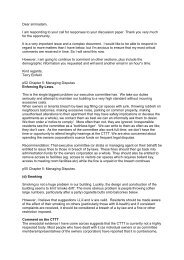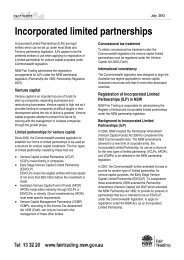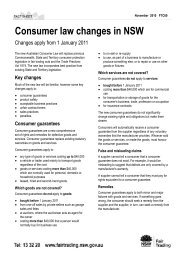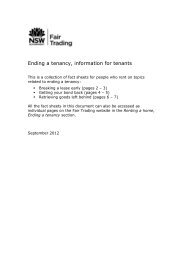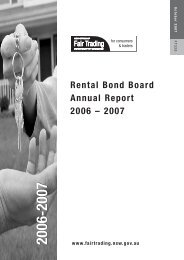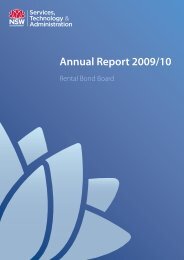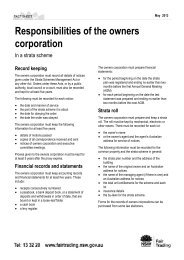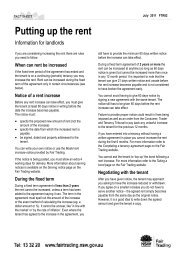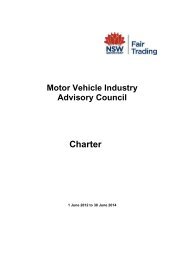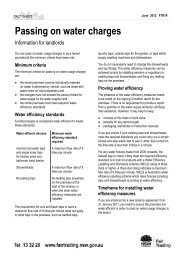High front guttering advisory committee report - NSW Fair Trading ...
High front guttering advisory committee report - NSW Fair Trading ...
High front guttering advisory committee report - NSW Fair Trading ...
You also want an ePaper? Increase the reach of your titles
YUMPU automatically turns print PDFs into web optimized ePapers that Google loves.
problems with high <strong>front</strong>ed <strong>guttering</strong> meeting performance requirements, because of the way<br />
slotted gutters had been specified as an overflow measure.<br />
Drawing on public records from the Australian Building Codes Board, slotted gutters were for many<br />
years the sole means mentioned for overflow in “Acceptable Construction Practice” and this was<br />
most evident under Amendment 2, in the 1998 version of the BCA. This remained the case up until<br />
the 2009 edition of the BCA when reference to slotted gutters was eventually removed.<br />
Of note, the singular inclusion of this method during this period has been seen by the Committee as<br />
sending a message to industry that slotted gutters were adequate on their own, without<br />
consideration of other or additional overflow measures i.e. additional measures that may be<br />
necessary in meeting the previously discussed performance requirement about not allowing water<br />
entry into the building based on a 100 year ARI. At the core of this problem was the fact that slots<br />
were specified in vague terms and did not include attention to size, spacing and location of slots; or<br />
the difference in measurable overflow performance that each provides. For instance it is evident<br />
that some high <strong>front</strong>ed <strong>guttering</strong> have significantly different slot sizes to others, thus making it<br />
misleading to lump all of them together – especially given different ARI values across the State.<br />
Though some may argue that “Acceptable Construction Practice” provides a degree of direction on<br />
this issue – for instance, the “Explanatory information” at the end of Clause 3.5.2 which states that<br />
“…in heavy down pours a slotted gutter may be inadequate” - it is notable that this text is for<br />
guidance only (refer BCA Clause 1.1.8), hence reducing its impact and weighting of attention.<br />
As a result, it can conceivably be concluded that those using slotted gutters under “Acceptable<br />
Construction Practice” between 1998 to 2009 could argue that they met the BCA’s performance<br />
requirements by virtue of meeting it’s own Deemed to Satisfy requirements, albeit that it is unclear if<br />
such measures (slotted gutters alone) meet BCA performance requirements– especially the need to<br />
prevent water entering the building based on the 100 year ARI.<br />
On a more general note, it was apparent to the <strong>committee</strong> that many people using the BCA have a<br />
limited understanding of how information is structured in it. For instance people regularly made<br />
general reference to work being “BCA compliant” and though there is nothing in essence wrong with<br />
this, it was at times apparent that such people were not aware of the difference between the BCA’s<br />
performance requirements as opposed to “Acceptable Construction Practice” (which is purely one<br />
option for Deemed to Satisfy construction). This has at times reduced the tenor of the debate and<br />
thus the ability to resolve issues pertaining to high <strong>front</strong>ed <strong>guttering</strong>.<br />
Of additional note, there is now virtually no guidance on appropriate overflow management for<br />
gutters in “Acceptable Construction Practice” albeit that this is important to the ability of high<br />
<strong>front</strong>ed <strong>guttering</strong> in meeting BCA performance requirements. It would be best to address this issue<br />
by introducing a more measurable and purposeful approach to overflow management in<br />
“Acceptable Construction Practice”.<br />
9 Issues Concerning AS3500.3 and 3500.5<br />
AS3500.3 and 3500.5 were the main options quoted by industry stakeholders used to comply with<br />
the BCA’s performance requirements. Whilst both documents provide well defined calculation<br />
procedures to determine roof catchment area, cross sectional area of eaves gutter, number of<br />
21



